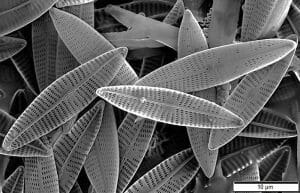Diatom Definition
Diatoms (pictured below) are a common type of unicellular phytoplankton that likely originated around the Jurassic period. Diatoms can form colonies characterized by particular shapes (e.g., stars, fans, and ribbons) and are encapsulated by a unique cell wall composed of silica, termed a frustule. The frustules of various diatom species are highly diverse and bilaterally symmetrical, with one value able to fit inside the other. In ecology, diatoms are used to monitor the water quality of large water bodies.
How to Diatoms Reproduce?
Diatoms primarily reproduce asexually via binary fission. Each daughter cell receives one of the frustules from the parent cell, which forms the larger frustule, and provides the basis for the construction of the second, slightly smaller frustule. Since, the two frustules are not the same size, with each replication, one daughter cell will be slightly smaller than the other. Thus, after several rounds of reproduction. The population of diatoms will be smaller than the original. Thus, to avoid a size-reduction or re-establish the original size of the diatom population, sexual reproduction must occur. Since the vegetative cells of diatoms are diploid, haploid gametes can be produced via meiosis. The fusion of the male and female gametes forms a zygote, which develops a membrane, termed the auxospore. Within the auxospore, a new diatom forms, which will then to produce new daughter diatoms. When environmental conditions change and resources become limited, diatoms can also produce resting spores, which germinate once the conditions become favorable. While diatoms themselves are not mobile, the male gametes of some diatom species are motile due to the presence of flagella. The female gametes of all species are large, immobile cells.
Where are Diatoms Found?
Diatoms can typically be found in all aquatic environments, including oceans, lakes, seas, wetlands, and streams. Diatoms have a high growth rate, and exhibit a “boom and bust” lifecycle. In accordance with the level of sunlight and nutrients found with the upper layers of the water, diatoms will either rapidly become the dominate phytoplankton species or go dormant until conditions improve. In this manner, the presence of diatoms are used to monitor water quality. Diatoms require high levels of silicon as an essential nutrient and since they are photosynthesizing organisms, diatoms also require sunlight.
Diatoms and Water Conditions
Brown rock: Some freshwater diatom species (e.g., Didymosphenia geminate) produces a brown substance when it blooms. This is associated with degradation in water quality and in some locations, this species is considered invasive.
Silicon: Diatoms are important for the regulation of silicon in the water. Typically, the “bloom” stage of the diatom life cycle is ended by the reduced availability of silicon at the surface of the ocean. This is because the silicon is required for the formation of the diatom cell wall.
Bloom and Bust: Diatoms exhibit a characteristic “bloom and bust” lifecycle in that when conditions are favorable, diatoms replicate rapidly (bloom) and when nutrients become depleted, they sink down into the lower layers of the water until conditions become favorable for growth (bust). These resting populations are brought back to the upper surface waters by vertical mixing processes that also serve to enhance the nutrient content of the water. Typically, this cycle occurs over the course of a year, with the bloom phase occurring over the spring and summer seasons. In some circumstances, however, blooms can also occur in the fall, if there is sufficient light for photosynthesis.
Quiz
1. Which of the following is TRUE regarding diatoms?
A. Diatoms reside in the deep waters during the bloom phase of their cycle
B. Silicon is a required nutrient
C. Diatoms reproduce all year long
D. Diatoms have a slow reproductive rate
2. Which of the following is FALSE regarding diatoms?
A. Diatoms follow a “bloom and bust” lifecycle
B. Silicon is a required nutrient
C. Diatoms have a rapid reproductive rate
D. Diatoms reside in deep waters during the bloom phase of their cycle
References
- Kinney, S et al. (2017). Gametogenesis and Auxospore Development in the Bipolar Centric Diatom Brockmanniella brockmannii (Family Cymatosiraceae). Protist. Nov;168(5):527-545.

